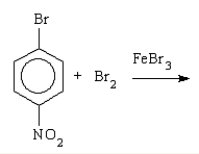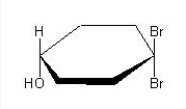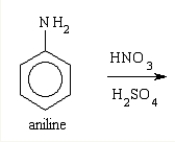Correct Answer

verified
B
Correct Answer
verified
Multiple Choice
Which of the following pairs react?
A) CH4(g) and KMnO4(aq)
B) CH4(g) and NaOH(aq)
C) CH4(g) and Cl2(g)
D) CH4(g) and HNO3(l)
E) CH4(g) and H2SO4(l)
G) All of the above
Correct Answer

verified
Correct Answer
verified
Multiple Choice
Which of the following undergoes electrophilic reactions?
A) ethanol
B) butane
C) 2-propene
D) chloroethane
F) C) and D)
Correct Answer

verified
Correct Answer
verified
Multiple Choice
Which of the following has the highest boiling point?
A) C3H8
B) CH3(CH2) 7CH3
C) CH3(CH2) 3CH3
D) CH3(CH2) 4CH3
E) CH3(CH2) 5CH3
G) C) and E)
Correct Answer

verified
Correct Answer
verified
Multiple Choice
The product of the reaction of 2-butene with Cl2 is
A) 3,3-dichlorobutane.
B) 2,3-dichlorobutane.
C) butane.
D) 2-chlorobutane.
E) 2,2-dichlorobutane.
G) B) and C)
Correct Answer

verified
Correct Answer
verified
Multiple Choice
A mixture of nitric acid and concentrated sulfuric acid is used to convert benzene to nitrobenzene.The nitrating agent in this reaction is
A) HNO3
B) NO2
C) NO2+
D) NO3
F) A) and B)
Correct Answer

verified
Correct Answer
verified
Multiple Choice
What major product(s) is (are) predicted from the following reaction? 
A) 1-chloro-1-phenylethane
B) meta-chloroethylbenzene
C) ortho- and para-chloroethylbenzene
D) ortho-chloroethylbenzene
E) para-chloroethylbenzene
G) B) and C)
Correct Answer

verified
Correct Answer
verified
Multiple Choice
What major product(s) is (are) predicted from the following reaction? 
A) None, the ring is deactivated and no reaction occurs.
B) 2,4-dibromonitrobenzene
C) 3,4-dibromonitrobenzene
D) 1,4-dibromobenzene
E) 1,2,3-tribromonitrobenzene
G) A) and D)
Correct Answer

verified
Correct Answer
verified
Short Answer
Name the compound CH3CH=CHCH=CH2.
Correct Answer

verified
Correct Answer
verified
Short Answer
Why do alkanes not react with boiling nitric acid?
Correct Answer

verified
Bebse the ...View Answer
Show Answer
Correct Answer
verified
View Answer
Short Answer
Name the compound CH2=CHC(CH3)CH(CH3)2.
Correct Answer

verified
3,4-dimeth...View Answer
Show Answer
Correct Answer
verified
View Answer
Short Answer
What is the missing compound in the reaction below? ethanol,70C CH3CH2CHBrCH3 +____ CH3CH=CHCH3 + Br + CH3CH2OH
Correct Answer

verified
CH3CH2OF1F1F...View Answer
Show Answer
Correct Answer
verified
View Answer
Multiple Choice
Consider the molecule below.Which of the following statements is correct regarding this molecule? 
A) The molecule in achiral.
B) The molecule is chiral.
C) The molecule has geometric isomers.
D) The molecule exists as two stereoisomers.
F) A) and B)
Correct Answer

verified
Correct Answer
verified
Multiple Choice
Heptane,with the formula,C7H16,can have how many isomeric structures?
A) 4
B) 5
C) 6
D) 7
E) 9
G) A) and D)
Correct Answer

verified
Correct Answer
verified
Multiple Choice
How many structural isomers are possible for hexane?
A) 9
B) 5
C) 7
D) 4
E) 6
G) C) and D)
Correct Answer

verified
Correct Answer
verified
Multiple Choice
Which of the following is optically active?
A) CH3CHClBr
B) (CH3) 2C(NH2) COOH
C) CH3CH2CH(NH2) COOH
D) NH2CH2COOH
E) Both A and C are optically active.
G) B) and C)
Correct Answer

verified
E
Correct Answer
verified
Short Answer
A dichlorobenzene reacts with HNO3/H2SO4 and produces three mononitrated products.Identify the initial dichlorobenzene.
Correct Answer

verified
Correct Answer
verified
Multiple Choice
Which of the following compounds has a chiral center?
A) CH3CH2CH(NH2) COOH
B) (CH3) 2C(NH2) COOH
C) CH3CHCH(Cl)
D) NH2CH2COOH
E) C(CH3) 4
G) B) and E)
Correct Answer

verified
Correct Answer
verified
Multiple Choice
What major product(s) is (are) obtained from the following reaction? 
A) ortho-nitroaniline and para-nitroaniline
B) para-nitroaniline
C) meta-nitroaniline
D) ortho-, meta-, and para-nitroaniline
E) ortho-nitroaniline
G) C) and D)
Correct Answer

verified
Correct Answer
verified
Multiple Choice
Consider the reaction of ethene with bromine water to produce 1,2-dibromoethane.Which of the following statements is correct regarding this reaction?
A) This reaction is a nucleophilic reaction.
B) This reaction is a substitution reaction.
C) A negatively charged intermediate is involved in this reaction.
D) A cyclic bromonium ion is an intermediate in this reaction.
F) None of the above
Correct Answer

verified
D
Correct Answer
verified
Showing 1 - 20 of 93
Related Exams